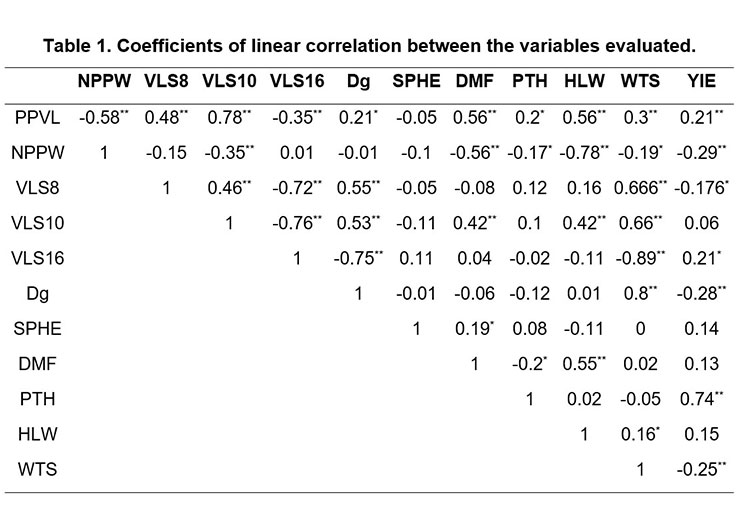Hectoliter weight and seed weight predict popping volume in amaranth
DOI:
https://doi.org/10.29312/remexca.v14i6.3025Keywords:
Amaranthus hypochondriacus, expansion volume, grain weight, hectoliter weightAbstract
Studies associated with the popping volume of amaranth (Amaranthus hypochondriacus L.) are practically nonexistent. The objective was to evaluate the relationship between characteristics of plant and raw grain with the popping volume of the popped grain. Between 2014 and 2015 2018-2019, five trials were established in Puebla, Mexico to evaluate the varieties Nutrisol, Revancha, Gabriela, Laura, Diego, Areli and PQ2 and three local populations. Characteristics of plant, raw and popped grain were measured. Positive and statistically significant (p≤ 0.01) correlations were observed between popping volume (PPVL) with hectoliter weight (HLW) (r= 0.56**) and weight of one thousand seeds (WTS) (r= 0.3**). It was also found that WTS and geometric seed diameter positively correlated with popped grain volume with size of 2.38 and 2 mm. Therefore, HLW and WTS could be used to help predict the behavior of popping volume in amaranth genotypes.
Downloads
References
Arapa, C. P. y Padrón-Pereira, C. A. 2014. Determinación de características físicas en semillas de quinua (Chenopodium quinoa Willd.) mediante procesamiento digital de imágenes. Rev. Venez. Cienc. Tecnol. Alim. 5(2):148-165.
Argumedo-Macías, A. 2019. Reventadora de semilla de amaranto (Amaranthus sp.). Agroproductividad. 12(11):111-113. https://doi.org/10.32854/agrop.vi0.1541.
Capristo, P. R.; Rizzalli, R. H. and Andrade, F. H. 2007. Ecophysiological yield components of maize hybrids with contrasting maturity. Agron. J. 99(4):1111-1118. doi:10.2134/agronj2006.0360. DOI: https://doi.org/10.2134/agronj2006.0360
Castro-Giráldez, M.; Fito, P. J.; Prieto, J. M.; Andrés, A. M. and Fito, A. P. 2012. Study of the puffing process of amaranth seeds by dielectric spectroscopy. J. Food Eng. 110(2):298-304. https://doi.org/10.1016/j.jfoodeng.2011.04.012. DOI: https://doi.org/10.1016/j.jfoodeng.2011.04.012
Dofing, S. M.; Tomas-Compton, M. A. and Buck, J. S. 1990. Genotype X popping method interaction for expansion volume in popcorn. Crop Sci. 30(1):62-65. https://dl.sciencesocieties.org/publicatio /cs/pdfs/30/1/CS0300010062. DOI: https://doi.org/10.2135/cropsci1990.0011183X003000010014x
Escobedo-López, D.; Ayala-Garay, A. V. y Campos-Silva, G. 2012. Formas de consumo del amaranto en México. Ed. Amaranto: Ciencia y Tecnología. INIFAO/SINAREFI. México, DF. 341-354.
INEGI. 2017. Instituto Nacional de Geografía e Informática. Anuario estadístico y geográfico de Puebla. Aguascalientes, México. 943 p.
Mishra, G.; Joshi, D. C. and Panda, B. K. 2014. Popping and puffing of cereal grain: a review. J. Grain processing storage. 1(2):34-46. http://www.jakraya.com/journal/pdf/2-jgpsArticle-1.pdf.
Mishra, G.; Joshi, D. C.; Mohapatra, S. and Babu, V. B. 2015. Varietal influence on the microwave popping characteristics of sorghum. J. Cereal Sci. 65(1):19-24. https://doi.org/10.1016/j.jcs.2015.06.00. DOI: https://doi.org/10.1016/j.jcs.2015.06.001
Morales, G. J. C.; Vázquez, M. N. y Bressani, C. R. 2014 El amaranto: características y aporte nutricio. 2da. Ed. Trillas. 131 p.
Ortiz-Torres, E.; Argumedo-Macías, A.; García-Perea H.; Meza-Varela, R.; Bernal-Muñoz, R. y Taboada-Gaytán, O. R. 2018. Rendimiento y volumen de expansión de grano de variedades mejoradas de amaranto para Valles Altos de Puebla. Rev. Fitotec. Mex. 41(3):291-300. https://www.redalyc.org/articulo.oa?id=61059021009.
Pordesimo, L. O.; Anantheswaran, R. C.; Fleischmann, A. M.; Lin, Y. E. and Hanna, M. A. 1990. Physical properties as indicators of popping characteristics of microwave popcorn. J. Food Sci. 55(5):1352-1355. https://doi.org/10.1111/j.1365-2621.1990. tb03934.x. DOI: https://doi.org/10.1111/j.1365-2621.1990.tb03934.x
Ramírez-Pérez, A. R.; Ortiz-Torres, E.; Argumedo-Macías, A.; O-Olán, M.; Jacinto-Hernández, C.; Ocampo-Fletes, I. y Díaz-Ruiz, R. 2018. Método para evaluar reventado de grano en amaranto. Rev. Mex. Cien. Agri. 9(3):675-682. http://dx.doi.org/10.29312/ remexca.v9i3.1224. DOI: https://doi.org/10.29312/remexca.v9i3.1224
SAS Institute. 2004. SAS/SATA 9.9. User’s Guide. SAS Institute Inc. Cary, NC. 1731-1900 pp.
Song, A. and Eckhoff, S. R. 1994 Optimum popping moisture content for popcorn kernels of different sizes. Cereal Chem. 71(5):458-460. https://www.cerealsgrains.org/ publications/cc/backissues/1994/Documents/71-458.pdf.
Soylu, S. and Tekkanat, A. 2007. Interaction amongst kernel properties and expansion volume in various popcorn genotypes. J. Food Eng. 80(1):336-341. https://doi.org/10.1016/j.jfoodeng.2006.06.001. DOI: https://doi.org/10.1016/j.jfoodeng.2006.06.001

Published
How to Cite
Issue
Section
License
Copyright (c) 2023 Revista Mexicana de Ciencias Agrícolas

This work is licensed under a Creative Commons Attribution-NonCommercial 4.0 International License.
The authors who publish in Revista Mexicana de Ciencias Agrícolas accept the following conditions:
In accordance with copyright laws, Revista Mexicana de Ciencias Agrícolas recognizes and respects the authors’ moral right and ownership of property rights which will be transferred to the journal for dissemination in open access. Invariably, all the authors have to sign a letter of transfer of property rights and of originality of the article to Instituto Nacional de Investigaciones Forestales, Agrícolas y Pecuarias (INIFAP) [National Institute of Forestry, Agricultural and Livestock Research]. The author(s) must pay a fee for the reception of articles before proceeding to editorial review.
All the texts published by Revista Mexicana de Ciencias Agrícolas —with no exception— are distributed under a Creative Commons License Attribution-NonCommercial 4.0 International (CC BY-NC 4.0), which allows third parties to use the publication as long as the work’s authorship and its first publication in this journal are mentioned.
The author(s) can enter into independent and additional contractual agreements for the nonexclusive distribution of the version of the article published in Revista Mexicana de Ciencias Agrícolas (for example include it into an institutional repository or publish it in a book) as long as it is clearly and explicitly indicated that the work was published for the first time in Revista Mexicana de Ciencias Agrícolas.
For all the above, the authors shall send the Letter-transfer of Property Rights for the first publication duly filled in and signed by the author(s). This form must be sent as a PDF file to: revista_atm@yahoo.com.mx; cienciasagricola@inifap.gob.mx; remexca2017@gmail.
This work is licensed under a Creative Commons Attribution-Noncommercial 4.0 International license.


